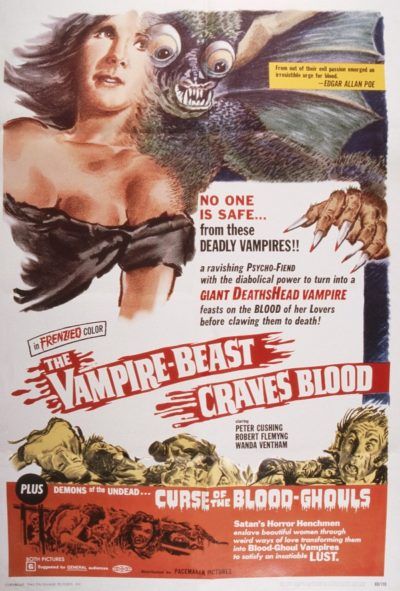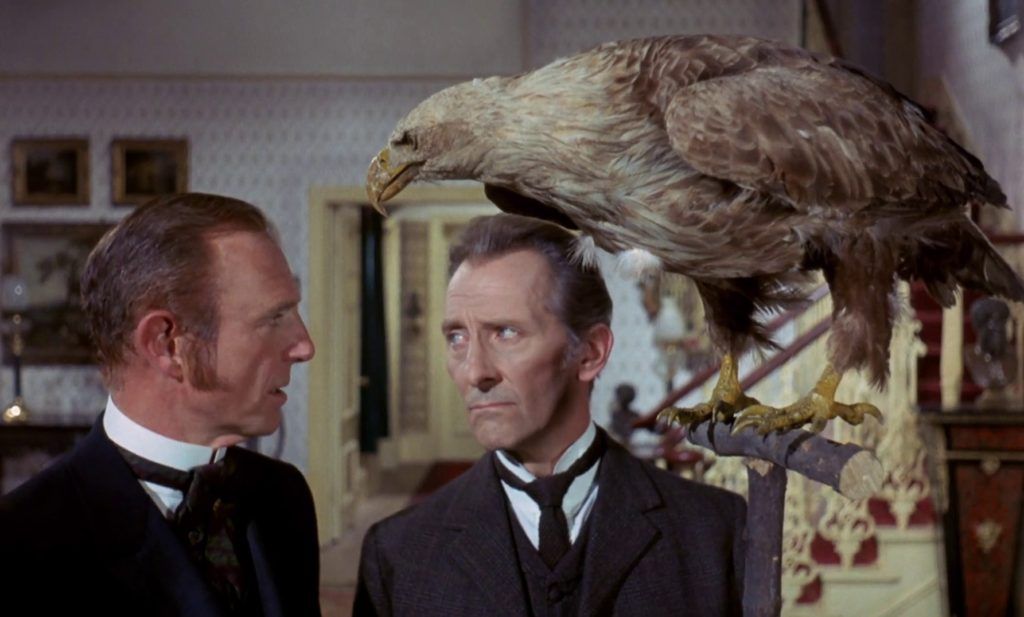
Rating: C
Dir: Vernon Sewell
Star: Peter Cushing, Robert Flemyng, Wanda Ventham, Vanessa Howard
a.k.a. Deathshead Vampire and The Vampire Beast Craves Blood
Is this a vampire film? Well, if the alternate titles are in any way unclear, it’s about a creature that flies and needs to drink human blood for sustenance. I’m invoking executive privilege and pronouncing it so, even if this lacks the standard supernatural trappings. It also stars Cushing as the “vampire hunter”, so case closed. Though we hadn’t got past the opening credits before Chris was asking, ‘Is this a Hammer movie?” While it’s not, it isn’t far away – literally. It was made by Tigon, who had begun as a distribution company before moving into production, and who shared premises with Hammer in Wardour Street. They were one of the genre-friendly studios which sprung up in the wake of Hammer’s success. Amicus were the most successful, particularly with their anthology films; Tigon were best known for Witchfinder General, released just three months after Blood Beast.
Cushing supposedly said this was his worst movie, made at a time in his career when he was perhaps less than discerning in his selection of parts, to help pay for his wife’s medical care. I can see his point, but as ever, Cushing elevates the material by his mere presence. It wasn’t an easy production either, Flemyng being a late replacement for Basil Rathbone, who died before shooting commenced. The budget was tight, and this is occasionally painfully apparent. The monster effects are very much a case of a script with ambitions way beyond its means. Be interesting to see what a modern remake, with decent resources, could do, because it’s certainly a novel idea. Maybe even unique, since I can’t think of any other movies which are based around a giant were-moth.
 Yes, you read that correctly. The exact logic and origin behind this is never adequately explained. It seems the creature is the creation of Professor Mallinger (Flemyng): how and why are questions simply left unaddressed. It takes the form of his daughter, Clare (Ventham – she nearly got the role given to Shirley Eaton in Goldfinger, and is Benedict Cumberbatch’s mum), who needs to take human blood in her moth form to survive. The resulting killings are being investigated by Inspector Quennell (Cushing), and he is understandably baffled by the bizarre evidence, including eye-witness reports of a flying creature and crime scenes dusted with what turns out eventually to be giant moth scales. When the authorities get too close to the Professor, he and Clare up stakes and head for the country, but Quennell follows, daughter Meg (Howard) in tow, because… well, the film needs a damsel in peril as it heads towards the finale. I won’t spoiler it, yet have to say the climax uses the most obvious of moth tropes.
Yes, you read that correctly. The exact logic and origin behind this is never adequately explained. It seems the creature is the creation of Professor Mallinger (Flemyng): how and why are questions simply left unaddressed. It takes the form of his daughter, Clare (Ventham – she nearly got the role given to Shirley Eaton in Goldfinger, and is Benedict Cumberbatch’s mum), who needs to take human blood in her moth form to survive. The resulting killings are being investigated by Inspector Quennell (Cushing), and he is understandably baffled by the bizarre evidence, including eye-witness reports of a flying creature and crime scenes dusted with what turns out eventually to be giant moth scales. When the authorities get too close to the Professor, he and Clare up stakes and head for the country, but Quennell follows, daughter Meg (Howard) in tow, because… well, the film needs a damsel in peril as it heads towards the finale. I won’t spoiler it, yet have to say the climax uses the most obvious of moth tropes.
You don’t see the monster for the first three-quarters of the film, though Chris had worked out Clare was involved well before the point this is revealed. Hard to say if this was a stylistic choice, one enforced by the budgetary restrictions, or because the makers were embarrassed by it. Perhaps they feared if it showed up earlier, it might provoke a stampede of patrons to the box-office, demanding refunds. It’s not very good, and certainly makes me look more kindly on the effects for the monster in The Gorgon, from four years earlier. That’s similarly female-themed, though this does give Clare greater independence, and there is less sense of her being a victim. She has convinced her “father” to start creating a Mr. Moth for her, though he eventually has qualms about that and ceases development, after she kills their gardener. I guess he was perfectly fine with her first six murders; the prospect of having untrimmed privet hedges was just a moral step too far…
I did wonder if it might end in Clare being trapped inside a giant killing jar of some kind. There’s a subplot about Meg meeting a young man who is a butterfly collector. They disagree over the morality of such things, Meg letting a specimen escape rather than become part of his stockpile. Beyond bringing her into the Mallinger circle, it doesn’t go anywhere, and is pretty much a waste of time. I suppose the collector does enlighten Quennell as to the meaning of the mysterious phrase “death’s head” uttered with his dying breath by one of the witnesses. Quite why the cop doesn’t Google it like everyone else, escapes me.
 As normal, Cushing anchors the more ridiculous elements of the plot with his commitment to the material. I also enjoyed the comic relief turn of Roy Hudd as an inappropriately cheery morgue attendant. Hudd gets a special credit, despite this being his first film role, being a familiar voice and face from radio and TV. Although this kind of role can be as welcome as a fart in a lift, it works here. Less effective is an odd segment where a group of students show up at the Mallinger’s and have a dress rehearsal for a play abut a mad scientist written for one of their number. I kept expecting this to turn into the play from Hamlet, triggering some sign of guilt or remorse in the Professor. Nope. It just brings things to a grinding halt for about ten minutes.
As normal, Cushing anchors the more ridiculous elements of the plot with his commitment to the material. I also enjoyed the comic relief turn of Roy Hudd as an inappropriately cheery morgue attendant. Hudd gets a special credit, despite this being his first film role, being a familiar voice and face from radio and TV. Although this kind of role can be as welcome as a fart in a lift, it works here. Less effective is an odd segment where a group of students show up at the Mallinger’s and have a dress rehearsal for a play abut a mad scientist written for one of their number. I kept expecting this to turn into the play from Hamlet, triggering some sign of guilt or remorse in the Professor. Nope. It just brings things to a grinding halt for about ten minutes.
The major flaws in the screenplay are all the more surprising, since it was not created by some inexperienced neophyte. Writer Bryan had a hand in a number of scripts for Hammer, perhaps most notably Plague of the Zombies. You wouldn’t know it based on the meandering misfire of a story here, which can’t be negated by the generally decent performances. The limited production values might have been acceptable twenty years earlier. When you consider this actually came out the same year as 2001: A Space Odyssey, the gulf between it and contemporary cinema is all the more obvious.
This review is part of our October 2023 feature, 31 Days of Vampires.
